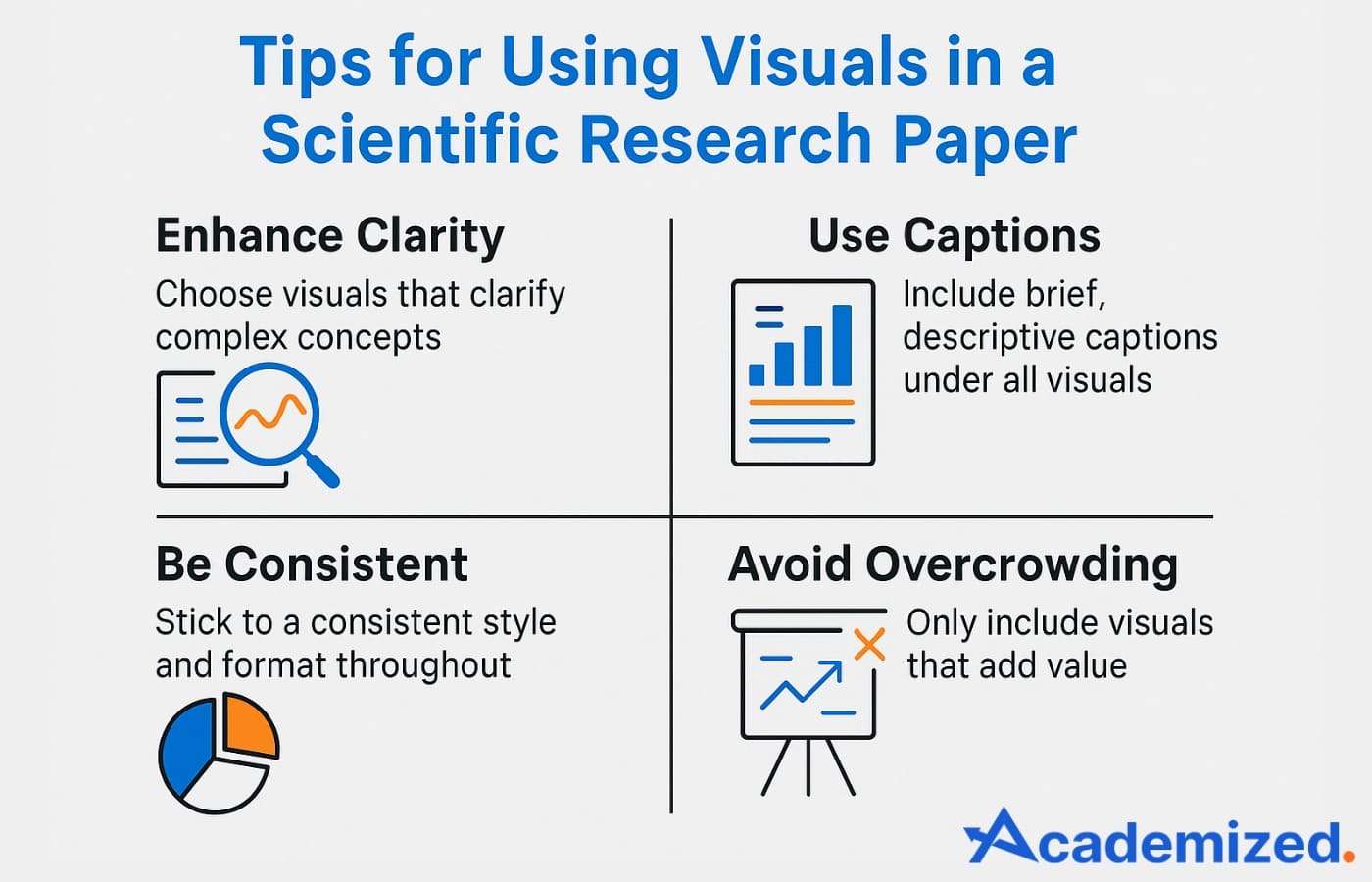- Blog
- How to Write a Scientific Research Paper: Tips From Real Scientists
How to Write a Scientific Research Paper: Tips From Real Scientists
 Mary Watson
Mary Watson

Ever wondered what makes a scientific research paper clear, reliable, and respected in academic circles? Curious how scientists and students turn ideas into organized, well-supported studies? You're not alone, and you're in the right place to find out how to make your paper top-tier!
So, how to write a scientific research paper that actually works? Start by breaking the process into manageable steps. From selecting a topic and forming a research question to gathering data and structuring your paper, each stage has a clear purpose. To create a strong scientific paper, you need more than just facts – you need logic, structure, and clarity.
As a team of academic writing professionals, we’ve helped countless students turn raw ideas into strong research projects. In this article, we’ll walk you through the process step by step, using our real experience to show you how to succeed – no fluff, just practical advice that works.
Defining a Scientific Research Paper
A scientific research paper is a formal document that explains the results of a study or experiment. It presents original findings backed by data and follows a clear structure that makes the information easy to verify and understand. Unlike general essays, this type of paper aims to inform, not persuade. It often answers a specific research question by presenting facts, observations, and analysis based on systematic investigation. A scientific paper must be objective, logical, and evidence-based, using sources and experiments to support every claim.
What is the Purpose of a Scientific Paper?
The main goal of a scientific paper is to communicate research clearly so that others can understand, review, and repeat the work, if needed. A strong paper doesn’t just share results – it explains how those results were reached and why they matter. This allows the scientific community to build on what’s already known, identify gaps, and avoid repeating the same mistakes.
When writing your own paper, make sure your focus stays on clarity and accuracy. You’re not writing to impress – you’re writing to explain. Be direct with your findings, support them with strong data, and organize your ideas in a way that others can follow. Every section should help answer your research question and support the final conclusion.
Familiarize Yourself With the Standard Scientific Research Paper Structure
Every scientific paper follows a clear, consistent format that helps keep the writing focused and professional. Each section plays a specific role in telling the story of your research. Here’s what to include:
- Title – Clearly reflects the topic and research question
- Abstract – Brief summary of your aim, methods, and main results
- Introduction – Explains background, why the topic matters, and outlines your goal
- Methods – Describes how the study was conducted so others can repeat it
- Results – Presents the findings using text, tables, or graphs
- Discussion – Explains what the results mean and how they relate to the bigger picture
- Conclusion – Restates key findings and suggests future research directions
- References – Lists the sources and studies you used
Pick a Research Topic That Fits the Field
Your topic sets the direction for your entire paper. It should be narrow enough to explore in detail but wide enough to find quality sources. Think about current challenges in science and how your interests connect with them. Make sure your question can be researched and tested with real data. Here are 10 trending topic ideas for scientific research papers:
- Effects Of Climate Change On Ocean Currents
- The Role Of Gut Microbiota In Human Health
- AI Applications In Early Disease Detection
- Renewable Energy Solutions For Urban Areas
- Genetic Editing Ethics And CRISPR Technology
- Microplastics In Food And Their Long-Term Impact
- Brain-Computer Interfaces And Neurotechnology
- Vaccine Development For Emerging Viruses
- The Future Of Space-Based Solar Power
- Nanotechnology In Targeted Cancer Treatment
How to Write a Science Research Paper: A Detailed Step-by-Step Guide
Once your topic is set, it’s time to start writing. Each section of a scientific research paper has a clear job to do, and writing them in the right order can help your paper stay focused and readable. Below, we’ll walk through how to handle the title and abstract, build an outline, write your introduction, and report your results.
Tips on Writing a Title and Abstract
Your title should give readers a clear idea of what your paper covers. Keep it brief, but include keywords that reflect your topic and methods. Avoid vague or overly creative phrasing – clarity matters more than clever wording. If you can, mention the subject, the type of study, and your main focus. For example: “The Effects of Urban Air Pollution on Plant Growth: A Controlled Field Study.”
An abstract comes after the title but is often written last. It summarizes the entire paper in about 150–250 words. A strong abstract includes:
- The purpose of the study
- Basic details of the methods
- A summary of key results
- The main conclusion
Do you require expert assistance with your scientific research project? Our essay writing help platform is equipped with all the tools to make your custom paper one of a kind!
Learn How to Write a Scientific Research Paper Outline
An outline organizes your ideas and helps avoid repetition. Before writing the full draft, use an outline to plan how each section will flow. It works like a roadmap, making sure each part of your paper has a purpose. Here’s a simple outline you can follow:
- Title – short, specific, and informative
- Abstract – summary of aim, methods, results, and conclusion
- Introduction
- Background information
- Research question
- Writing a thesis for a scientific research paper
- Methods – tools, procedures, and materials used
- Results – main findings with tables or figures
- Discussion – what the results mean and why they matter
- Conclusion – wrap-up of key points and future implications
- References – full list of cited works
Learn What Makes a Solid Scientific Research Paper Introduction
The introduction gives context for your study and explains why your research matters. It should lead readers from general background information to your specific question. Keep it focused – this isn’t the place to list everything you know about the topic. Instead, give enough detail to explain the issue clearly.
Start with a brief overview of the broader topic, then explain what past research has already found. After that, narrow down to the gap your study is trying to fill. End this section with your main research goal and a clear, specific statement of what the paper will cover. If you're writing a thesis for a science research paper, make sure it's focused, evidence-based, and answers the research question you’ve posed.
Read more: How to Write a Scientific Essay
Build Focused Science Research Paper Body Paragraphs
Writing the body paragraphs of a science research paper means focusing on one idea at a time and backing it up with evidence. Each paragraph should begin with a clear topic sentence that connects directly to your thesis. Follow that with data, examples, or references to support your point. Keep the tone factual and avoid personal opinions. Use figures or tables when needed, but always explain what they show in the text. Transitions between paragraphs should be smooth to help readers follow your logic. Stay concise, and make sure every paragraph contributes to answering your research question.
Put Together an Informative Results Section
The results section is where you present your findings without interpretation. This is not where you explain what the results mean – that comes later in the discussion. Instead, this part should be clear, well-organized, and supported by visuals like tables, charts, or graphs, when appropriate.
Arrange your results logically, often following the sequence of your methods or research questions. Use subheadings if needed to break up complex data. Each piece of data should have a short explanation, but avoid making claims or discussing implications here. Just report the facts clearly, and let the data speak for itself!
Create an Evidence-Based Discussion Section
The discussion section is where you interpret your findings, link them to your research question, and compare them with what others have discovered. Focus on what your data shows – not what you hoped to find. Keep it honest and grounded in evidence.
Start by summarizing your main results. Then, explain how they connect to your original hypothesis and previous studies. If your results support or challenge existing research, say so and explain why. It’s also important to talk about any limitations in your study – no research is perfect, and pointing out weaknesses shows credibility. End with ideas for future studies or practical ways your findings could be applied.
Read more: Guide on Writing an Evaluation Essay
Sum up With a Precise Scientific Research Paper Conclusion
The conclusion is your final chance to wrap up the study and leave readers with a clear understanding of its value. This section should briefly restate your research question, remind readers of your key findings, and highlight the overall significance.
Keep your conclusion focused and avoid repeating data from earlier sections. Instead, tie everything together in a simple, direct way. Don’t introduce new points here. Instead, end with a clear message – what does your research contribute, and why should people care about it? A strong conclusion leaves the reader with a clear takeaway and often includes a short suggestion for future research directions.
Mind the Fitting Writing Style and Tone
Scientific papers require a writing style that is clear, direct, and neutral. Your goal isn’t to impress with fancy words – it’s to explain your research in a way that’s easy to understand and verify. Stick to facts and use straightforward language. Always avoid personal opinions or emotional wording.
Write in the third person and use the past tense when describing what you did. Keep sentences short and focused. Define any technical terms clearly and don’t assume the reader knows everything you know.
Avoid vague phrases like “it is believed” or “some people say.” Be specific and base every claim on evidence. A professional, precise tone builds trust in your work and shows respect for the scientific process.
Adhere to a Proper Scientific Research Paper Format
Formatting may seem minor, but it plays a big role in how your paper is received. Clean formatting shows that you follow academic standards and pay attention to detail. These tips for writing a science research paper will help keep your document polished and professional:
- Follow the citation style (APA, MLA, or Chicago) required by your instructor or field
- Use a 12-point readable font like Times New Roman or Arial
- Set 1-inch margins on all sides
- Double-space the entire document, including references
- Include page numbers in the top corner
- Add clear section headings and subheadings to guide the reader
- Label all tables, graphs, and figures clearly, and refer to them in the text
- Include a full reference list at the end, formatted correctly
Don’t Forget to Cite all the Sources
Giving credit to original sources is not just a formality – it’s a key part of academic honesty. Proper citations show where your data and ideas came from and help others trace the research you used. Failing to do this correctly can lead to unintentional plagiarism, even if the mistake was accidental.
Always check what citation style your course or field requires. The most common ones include APA, MLA, and Chicago, each with its own rules for how to list books, articles, and websites. Make sure your in-text citations match the full references at the end of your paper. Try using citation tools to help, but always double-check them manually. If you're looking for ways to write a scientific research paper that meets professional standards, citing accurately is essential.
Need a custom science paper in just 3 hours? No problem! At Academized.com, you can buy a research paper online and get a fairly-priced custom essay fast.
Utilize Helpful Visuals Effectively
Charts, graphs, and tables aren’t just for decoration – they make complex data easier to understand. A well-designed visual helps the reader see patterns or comparisons that might get lost in a wall of text. When used right, visuals can make your argument stronger and your paper more convincing.
Keep each visual clean and simple. Add labels and a title that clearly explain what’s being shown. Refer to every figure or table in the text, so readers know when and where to look at them. Don’t overload your paper with too many visuals – include only what adds real value. One of the best ways to write a scientific research paper is to use visuals as a tool for clarity, not filler.

Never Skip the Final Look-Over and Get Feedback
No matter how well you write your first draft, editing is what turns it into a solid final version. Start by reviewing the structure and content. Check that each section flows logically, supports your thesis, and stays on topic. Make sure all your claims are backed by data.
After that, focus on language. Look for awkward phrasing, repeated words, or overly long sentences. Read your paper out loud – it’s a simple way to catch small mistakes or confusing lines. Ask someone else to read it once you’ve gone through it a few times. A fresh set of eyes can spot things you missed. Outside feedback helps improve clarity and gives you a better idea of how your paper reads to others, whether it's a classmate, tutor, or professor.
Check out this Expertly-Crafted Scientific Research Paper Example
Seeing a full example of a scientific research paper makes understanding how everything comes together easier. Below is a simplified sample that shows how to follow structure, keep your writing clear, and stay focused on the purpose of the study.
Title: The Impact of Light Intensity on the Growth Rate of Bean Plants
Abstract:
This study investigates how different light levels affect the growth rate of bean plants. Over a three-week period, three groups of plants were exposed to low, medium, and high light conditions. Measurements were taken daily. Results showed that medium light produced the highest average growth, suggesting that too much or too little light can limit plant development.
Introduction:Light is essential for plant growth, but too much or too little can affect how plants develop. While it's known that light powers photosynthesis, there’s less agreement on the exact light levels that produce the healthiest growth. This study asks whether bean plants grow faster under medium light conditions than under low or high light.
Methods:
Three groups of bean plants were grown under different light levels: 4 hours, 8 hours, and 12 hours of light daily. Each group had 10 plants of the same variety, planted in identical soil and containers. Watering, temperature, and humidity were kept constant. Plant height was recorded every 24 hours for 21 days.
Results:
On average, plants exposed to 8 hours of light grew 18 cm by day 21. Those in the 4-hour group reached only 11 cm, while the 12-hour group grew to 14 cm. Growth was fastest during the second week for all groups, but slowed during the final days in the 12-hour group.
Discussion:
The results suggest that moderate light exposure supports the most consistent and rapid plant growth. Too little light clearly slowed development, likely due to reduced photosynthesis. In contrast, excessive light may have stressed the plants, causing slower progress by the third week. These findings align with earlier studies suggesting optimal light ranges support healthier plant development.
Conclusion:
Bean plants exposed to 8 hours of light daily grew faster than those in low or high light conditions. This supports the idea that moderate light creates the best conditions for plant growth. Future studies could test different plant species or explore how other factors, like temperature, interact with light levels.
Get Some Final Pro Tips from Our Academic Writers
Writing a scientific paper takes more than just collecting data – it also involves organizing ideas clearly and presenting them with purpose. Based on our experience working with students and researchers, we’ve gathered key insights that improve both writing quality and research clarity. These scientific research paper techniques in writing can help you write with more precision and confidence:
- Break your writing into short, focused sections to keep your ideas clear and organized
- Keep your thesis and research question visible as you write, so every section stays on track
- Use figures and tables to support – not replace – your explanations
- Avoid filler words and overly complex phrases that don’t add meaning
- Stick to the past tense when describing experiments and observations
- Review papers from your field to see how professionals structure their arguments
- Ask someone unfamiliar with your topic to read your paper for clarity
- Track your sources as you go to avoid citation errors later
- Reread your abstract after finishing the paper – it often needs tweaking to match your final results
- Save multiple drafts so you can compare and refine your wording more easily
Dodge these Common Mistakes
Even strong research can fall flat if your writing isn’t careful. Certain issues come up again and again, especially for students writing their first few papers. These are some common mistakes we see – and ones you’ll want to watch for:
- Writing without a clear research question or thesis
- Including too much background and not enough analysis
- Using vague language or unsupported claims
- Mixing up the purpose of each section (e.g., interpreting results in the methods section)
- Forgetting to explain figures or charts in the text
- Skipping proper citations or formatting references incorrectly
- Repeating the same phrases or words too often
- Ignoring the word count or spacing guidelines
- Waiting too long to start editing or revising
- Submitting the first draft without feedback
The Issue of Ethics in Scientific Writing
Academic writing in science comes with serious responsibilities. Every part of your paper should reflect honesty, accuracy, and respect for the work of others. Ethical writing isn’t just about avoiding plagiarism – it’s about building trust in your research and making a meaningful contribution to your field.
Start by giving full credit to all the sources and ideas that influenced your study. Even if you reword something, you still need to cite the original author. Make sure your data is reported truthfully, even if the results weren’t what you expected. Avoid exaggerating your findings or leaving out results that don’t match your hypothesis.
If your research involves human or animal subjects, follow all guidelines for informed consent, confidentiality, and humane treatment. Always check your institution’s research policies before you begin.
Finally, don’t submit the same paper to multiple journals or classes unless you have clear permission to do so. Respect the process, and your work will stand on solid ground.
Read more: Learn How to Write a Research Paper
Bonus Peer Review Checklist for the Ultimate Win
A final review by a peer or mentor can uncover small issues that make a big difference. Before you hit “submit,” take time to check your paper carefully. Use this checklist to make sure your work is clear, complete, and ready for review:
- Have I answered the research question clearly?
- Is the thesis well-defined and consistent throughout the paper?
- Are all sections included and correctly structured?
- Do my methods allow for replication?
- Are the results presented with the right visuals and explanations?
- Does the discussion section interpret findings without repeating them?
- Have I cited all sources correctly and formatted references properly?
- Are all figures, tables, and captions accurate and clear?
- Is the language clear, objective, and free from grammar errors?
- Has someone else read the paper and provided honest feedback?
Concluding Thoughts and Tips from the Author
After helping students for years and writing my own papers, I’ve come to appreciate just how much of a process scientific writing really is. The first one I ever wrote was clunky and way too long. I tried to sound "smart" instead of clear. I didn’t yet understand that good writing in science is about simplicity, not complexity.
Over time, I stopped trying to impress and started trying to explain. That one shift changed how I approached every section, from the thesis to the conclusion. Now, I always tell students to picture their reader as someone intelligent but not yet familiar with the topic. If you can make your research easy to understand, you’ve already done half the work!
Don’t rush the editing phase. Some of my best revisions came from taking a break, then coming back with fresh eyes – or better yet, letting someone else read it. Writing a solid scientific research paper takes patience, but every round of edits brings you closer to clarity and confidence.
Read also: How to Write a Strong Analytical Research Paper
FAQ
How long does it take to write a scientific research paper?
The timeline can vary, but, on average, it takes between 2 and 6 weeks to write a solid draft, more if your research is complex. Most of that time goes into outlining, editing, and making sure everything is supported with real data.
How to start a scientific research paper?
Begin with a brief background to introduce the topic and explain why the research matters. Then narrow the focus and end with a clear thesis or objective. Example:
Climate patterns have shifted rapidly over the last two decades, yet their impact on seasonal crop growth remains understudied. This paper explores how temperature changes influence corn yield in the Midwest.
How to end a scientific research paper?
Wrap up by restating the main finding, briefly explaining its importance, and suggesting what could come next. Keep it short but meaningful. Example:
These results show a strong link between soil pH and seed germination rates, suggesting that minor soil changes can impact early crop success. Future studies could examine this effect across multiple plant types.
What is the format of a scientific research paper?
A standard paper includes these sections: Title, Abstract, Introduction, Methods, Results, Discussion, Conclusion, and References. Each one serves a different purpose, but should connect back to your research question and data.

Mary, our exceptional editor and online tutor, brings a wealth of knowledge to the table. With her extensive expertise in academic writing, she guides and mentors aspiring students, providing them with constructive feedback that propels their essays to the next level.



